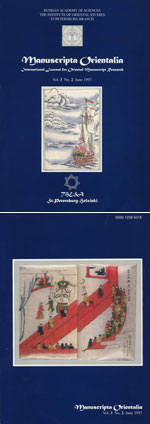|
|
| |

|

|
Akimushkin O. F. On the Date of al-Ṣiḥāḥ al-‘Ajamiyya’s Composition // Manuscripta Orientalia. Vol. 3. No. 2. June 1997. P. 31—32.
Among a significant group of Persian dictionaries composed in the medieval Middle East a special place belongs to al-Sihah al-'Ajamiyya. A certain priority of this work was determined presumably by the following factors: i) it is probably one of the oldest surviving Persian-Oghuz (Azerbaijanian) dictionaries; ii) a considerable volume of Persian vocabulary is represented there (over five and a half thousand lexems); iii) practically every author working on lexicography used this work ; iv) judging by the number of the surviving copies (about 40), the dictionary was well-known and was circulated among different social groups.
The dictionary contains a wide range of the common and everyday Persian words along with a whole layer of Arabic words which became interwoven into the fabric of the Persian literary language. The dictionary is not supplied with quotations from poems to confirm the meaning of the words. This last means that it was not designed to be a dictionary of rhymes but, as it is marked by its author in a brief introduction in Arabic, it was intended to give a precise meaning and explanation of a Persian word in Turkic.
Besides this introduction the dictionary actually consists of two parts (qism) and a supplement (tatimma). The first part is a dictionary of nouns, the second — of infinitives, while the supplement provides brief explanations of the grammatical structure of the Persian language, focusing mainly on the conjugation of Persian verbs. It is not necessary to consider here in all detail the structure of this lexicographic work — this information one can find in reference-books and in numerous catalogues . The work was published in Tabriz in 1983 by Professor Ghulam-Husayn BTgdilT on the basis of a single copy from the University Library of Bratislava (Slovakia) .
The controversy which arose around rather vague evidence of the seventeenth century Turkish bibliographer Hajji Khalifa concerning the authorship of the dictionary (none of the existing copies reveal the name of the author) was decided in favour of a famous scholar originating from Nakhichevan (Azerbaijan), Fakhr al-Din Hindushah b. Sanjar Sahibi Girani Nakhchiwani. He stays in the history of Persian and Azerbaijan culture as a connoisseur of Arabic, a historian, lexicographer, and writer. Among his works is the anthology of Arabic poetry Mawarid al-adab composed in Tabriz in 707/1308. In 724/1324 he wrote a historical treatise — Tajarib al-salaf containing two parts. The first one is a translation from Arabic into Persian of the historical section of Kitab al-Fakhri by Ibn al-Tiqtaqa (701/1301). The second part is an original writing that contains much additional information on the history of the Fatimid dynasty in Egypt, on the Buwayhids, and the Seljukids in Iran .
The date of birth of Hindushah is considered to be unknown, as well as the exact date of his death. He died presumably in 730/1329—30. There is, however, a reason to believe that he had died after the accomplishment of Tajarib al-salaf, but before 728/1327—28, since his son, the famous munshi Shams al-Din Muhammad (b. 687/1288 in Nakhchiwan) mentions him as “departed to the other world” in his Persian explanatory dictionary entitled Sihah al-Furs (2,300 entries) which he began in 728/1327—28.
Until recently a number of specialists in Turkic and Iranian studies were dubious of Hindushah's authorship of al-Sihah al- 'Ajamiyya, suggesting that its author had been either one shaykh Yahya al-Amm al-Rumi al-Qurashi or Taqi al-Din Muhammad b. Pir 'Ali Barkawi (or Birghili). The latter died in 981/1573—74. According to the same HajjT Khalifa, he compiled a work under the same title. If we accept the last point of view , then the Persian-Turkic dictionary al-Sihah al-'Ajamiyya should have been composed in the middle of the sixteenth century. In this case, it cannot be regarded as one of the earliest Persian-Oghuz dictionaries.
The controversy, however, may be settled in a very simple way, if evidence of a man of letters, a scribe who lived 500 years ago, be taken into account. Owing to his careful attitude to his work and to the text of the protograph he was ordered to copy, we have all necessary information on the subject. That scribe, one Mir Husayn, in the middle of the month of Dhu'l-Hijja 878/early May 1474 made a copy of a volume (preserved now in the Library of the Cambridge University, call No. LI. 6.10) folios lb—106a of which were occupied by the dictionary al-Sihah al-'Ajamiyya. In this volume Mir Husayn had copied out the colophon by the author of the writing that runs as follows:
“With the good assistance and help [of Allah] accomplished is al-Sihah al-'Ajamiyya, without which no one striving to get the knowledge of the Persian language can do, be he a youth or a grown-up, after the sunrise on Tuesday, at the end of the noble month of Dhu'l-Hijja of the year 677, let Allah help the author of this work and all other Muslims”. .
Now, due to the scribe Mir Husayn, we can safely say that Hindushah NakhchiwanT accomplished his lexicographic work on Tuesday, 8 May 1279, and that the old controversy is settled at last.
|
|
|
|
|

